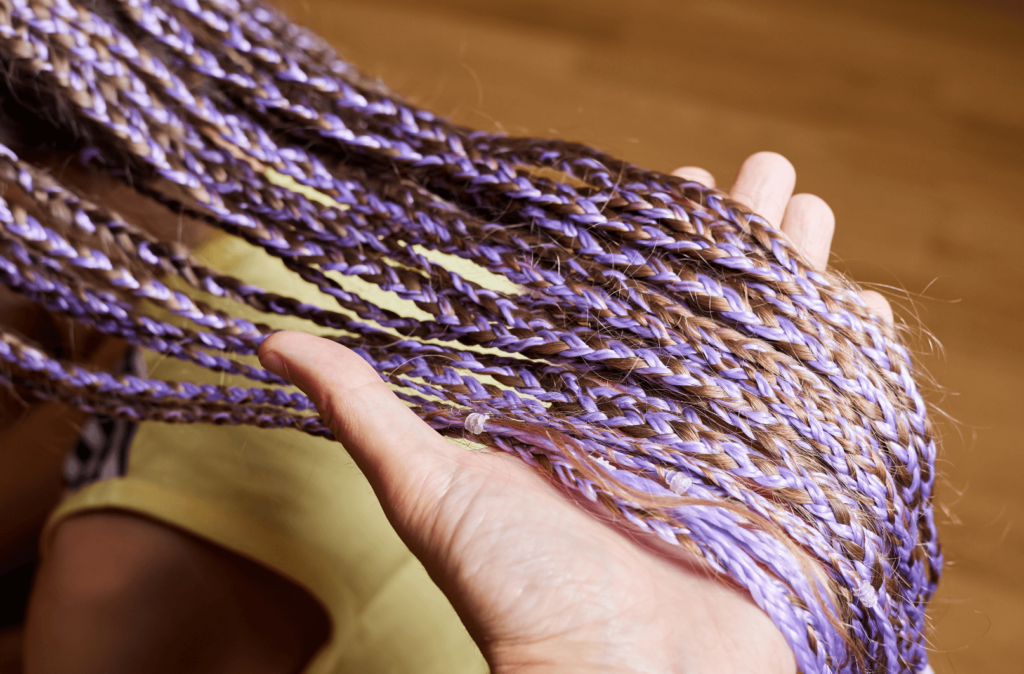
Introduction: The Cultural Significance vs. Health Risks of Synthetic Braids
For centuries, braided hairstyles have served as more than just aesthetic choices in Black communities—they’re cultural signatures, protective styles, and statements of identity. Today, synthetic braiding hair dominates the market due to its affordability, versatility, and low maintenance. However, emerging scientific evidence reveals that these convenient extensions may come at a dangerous cost to health.
Key Findings from Recent Studies:
- 100% of tested synthetic braiding hair contained carcinogens (Consumer Reports, 2023)
- 90% contained lead—a neurotoxic heavy metal
- All samples released VOCs (volatile organic compounds) linked to respiratory damage
This article will:
✔ Examine the toxic chemicals in synthetic braids at a molecular level
✔ Detail proven health risks (from skin burns to cancer)
✔ Provide science-backed alternatives that protect both hair and health
The Chemistry of Synthetic Braiding Hair – What’s Really in Your Extensions?
1. Base Materials: Petroleum-Based Plastics
Most synthetic hair is made from:
- Modacrylic fibers (acrylic + vinyl chloride copolymers)
- Kanekalon (a modacrylic fibre variant)
- PVC (polyvinyl chloride)
Why This Matters:
These plastics are derived from petrochemicals—the same source as gasoline and industrial solvents. During manufacturing, they’re processed with:
|
Chemical Additive |
Purpose |
Health Risk |
|
Phthalates |
Softens fibres |
Endocrine disruptor (linked to infertility) |
|
Organotins |
Stabilises PVC |
Immune system damage |
|
Brominated flame retardants |
Prevents melting |
Neurotoxicity |
2. Carcinogens Detected in Synthetic Braids
Independent lab tests found:
A. Benzene (Known Human Carcinogen)
- Source: Used in dyeing synthetic hair jet black
- Health Impact:
- Leukaemia risk (EPA states no safe exposure level)
- Dermal absorption occurs through scalp contact
B. Methylene Chloride & Chloroform
- Source: Solvents in adhesive coatings
- Health Impact:
- Liver/kidney damage (FDA banned in cosmetics in 2019)
- Volatilises when heated (from styling tools) → lung irritation
C. Lead (Heavy Metal Contaminant)
- Source: Industrial pollution during manufacturing
- Health Impact:
- Neurodevelopmental harm (especially in children)
- Accumulates in bones/kidneys over time

Documented Health Effects – From Skin to Systemic Damage
1. Immediate (Short-Term) Reactions
- Contact Dermatitis:
- Symptoms: Redness, itching, blisters
- Cause: Phthalates leaching into scalp sweat
- Chemical Burns:
- Trigger: Alkaline sprays used to “seal” braids
- Case Study: The Journal of Clinical Dermatology (2022) documented 2nd-degree burns from synthetic hair adhesives
- Respiratory Distress:
- Mechanism: VOCs (acetone, toluene) released during installation → asthma attacks
2. Long-Term Risks
A. Cancer
- Benzene exposure → 40% higher leukaemia risk (NIH, 2021)
- Vinyl chloride (in PVC) → liver angiosarcoma
B. Neurological Damage
- Lead toxicity → reduced IQ in children, memory loss in adults
C. Reproductive Harm
- Phthalates → lower sperm count, early puberty (EWG, 2023)
Why Aren’t These Products Regulated? The Systemic Failure
1. FDA Loopholes
- Synthetic hair is classified as a “cosmetic accessory” (not a drug/device) → no pre-market safety testing
- Only 11 chemicals banned in cosmetics (vs. 1,400+ in EU)
2. Environmental Racism in Beauty Standards
- Market Analysis: 89% of synthetic braid products target Black women (Beauty Justice Report, 2023)
- Health Disparity: Scalp disorders are 3x higher in Black women vs. other groups (JAAD, 2022)
Science-Backed Safer Alternatives
1. Natural Human Hair
- Pros:
- Chemical-free if unprocessed
- Biocompatible (no allergic reactions)
- Cons:
- Cost:
- 200+vs.
- 200+vs.20 for synthetic
- Ethical concerns (source transparency needed)
Brand Recommendation:
- REMY NY (traceable, vegan-bonded human hair)
2. Plant-Based Fibers
- Banana Fiber Braids (ReGen by Rebundle):
- Biodegradable
- Hypoallergenic (no phthalates/VOCs)
3. Non-Toxic Synthetics
- SLAYYY Hair:
- Patent-pending “CleanWeave” tech removes 99% of VOCs
- Lab-certified lead-free
Protective Measures If Using Synthetic Hair
1. Pre-Installation Detox
- Soak braids in:
- 1 cup ACV + 2 cups water (removes surface chemicals)
- Bentonite clay mask (binds heavy metals)
2. Wear Time Limits
- Max 4 weeks (prevents chemical migration into the scalp)
3. Styling Precautions
- Never heat above 300°F (triggers VOC release)
Conclusion: Reclaiming Beauty Without Compromising Health
The synthetic braiding hair industry has prioritised profit over safety for decades—but consumers now have power through education. By:
✔ Choosing verified non-toxic brands
✔ Demanding FDA reforms (#BanToxicBraids campaign)
✔ Consulting scalp specialists for chemical injury
We can honour cultural traditions without sacrificing well-being.
Get a Scalp Health Assessment Today
At The Skincare Network, our ethnically diverse dermatologists specialise in:
🔬 Patch testing for synthetic hair allergies
Book Now:
🌐 www.skincarenetwork.co.uk
